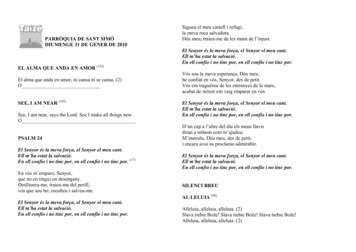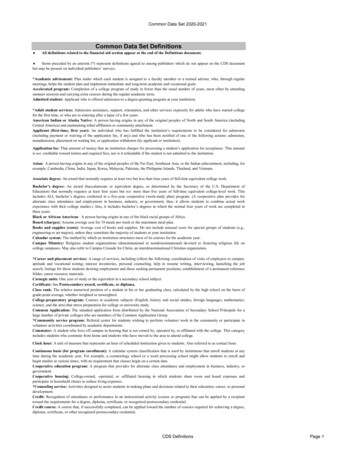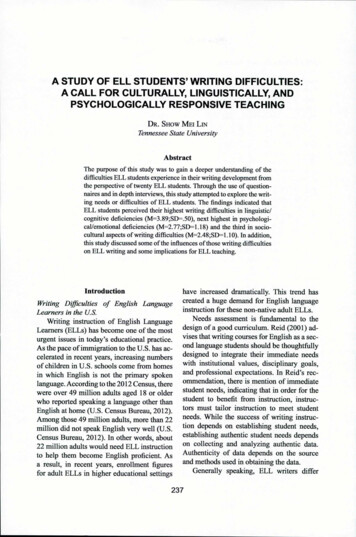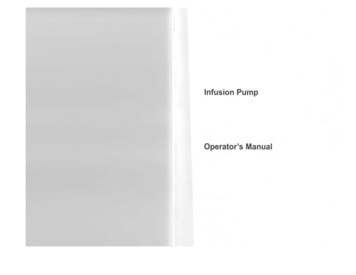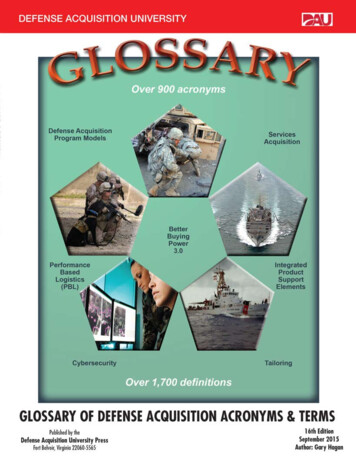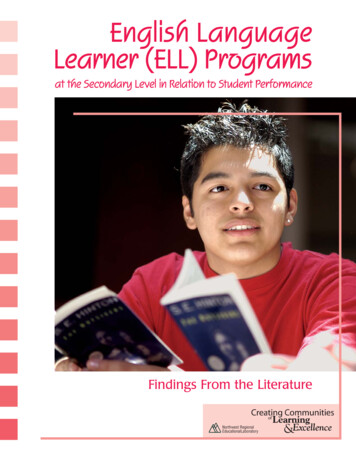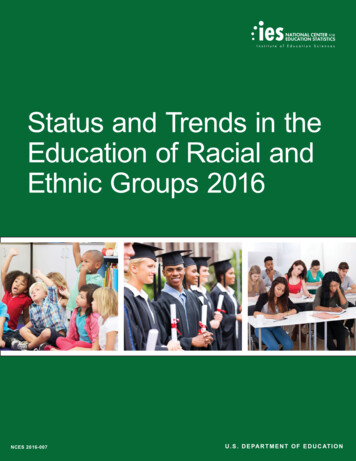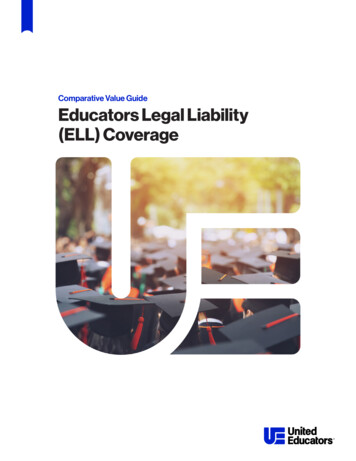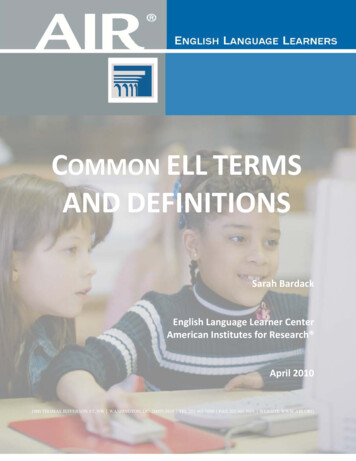
Transcription
COMMON ELL TERMSAND DEFINITIONSSarah BardackEnglish Language Learner CenterAmerican Institutes for Research April 20101000 THOMAS JEFFERSON ST, NW WASHINGTON, DC 20007-3835 TEL 202 403 5000 FAX 202 403 5001 WEBSITE WWW.AIR.ORG
ACKNOWLEDGMENTSContributors to this glossary include Libia Gil, PhD; Jennifer O’Day, PhD; Anestine Hector‐Mason, PhD; and Carlos Rodriguez.
INTRODUCTIONThis glossary is a resource for professionals involved in English language learner (ELL) education,and represents a first step toward developing a comprehensive catalogue of terms and definitionsto aid educators in their work with the increasing population of ELLs across the country.The complexity and heterogeneity of the ELL population in the United States has increaseddramatically in recent history. ELLs have different levels of language proficiency and differentsocioeconomic status, academic experiences, and immigration history. Thus, they do not fit a singleprofile. In addition, ELLs represent the fastest growing segment of the student population in theUnited States. An estimated 70% of ELLs are concentrated in 10% of U.S. schools, and nearly 45% ofthe adults enrolled nationwide in state‐administered adult education programs attend English as asecond language (ESL) or English literacy classes (Clewell & Consetino de Cohen, 2007; U.S.Department of Education, Office of Vocational and Adult Education, 2006).This glossary includes the most current vocabulary regarding ELLs and ELL education. It alsoidentifies the terms or definitions that are obsolete, including some that may perpetuate negativestereotypes. The glossary is divided into two major sections; the first section focuses onterminology that refers to ELLs, as well as to instructional and programmatic practices, and thesecond section focuses on ELL programmatic models. Overall, the variety of these expressions andtheir definitions illustrates the challenge of developing consistent and current language thataccurately applies to ELLs.Note: Many of the definitions in this document are based on a glossary prepared by the MichiganAssociation for Bilingual Education (n.d.).
COMMON ELL TERMS AND DEFINITIONSI. ELL Terminology1st (first) generationForeign‐born and often foreign‐educated ELLs.2nd (second) generationUnited States–born children of immigrants.Accommodation1Appropriate modifications or changes to tests and testing procedures so that ELL content knowledgeis more accurately measured. Appropriate accommodations (e.g., allowing extra time to take a test,providing dictionaries, and making changes to materials, protocols, or the testing conditions) areused to facilitate the valid participation of ELLs in assessments without undermining the testconstruct.Additive bilingualismA philosophy that is reflected in instructional approaches such as dual language and developmentalbilingual education. Such approaches promote the acquisition of a second language withoutimpeding the development of the first language.Alternative language programA term used by the Office of Civil Rights (OCR) to refer to an instructional program that the officedeems appropriate for ELLs. OCR does not require or encourage a specific type of program orapproach to instruction for ELLs; it allows districts substantial freedom when choosing alternativelanguage programs (Office of Civil Rights, n.d.). Alternative language programs incorporate either abilingual education approach or an English‐only approach, depending on the philosophy of theimplementing school or agency.Ancestral languageHome or family language. In English‐speaking countries, for example, a language other than Englishthat is spoken at home or was spoken by an individual’s ancestors is considered an ancestrallanguage.Annual measurable achievement objective (AMAO)AMAOs are state requirements or indicators for measuring ELL progress in learning English, theattainment of English language proficiency, and ELL annual yearly progress (AYP) in meeting statestandards. Local education agencies that receive Title III funding (the English Language Acquisition,Language Enhancement, and Academic Achievement Act) under the Elementary and Secondary1The term accommodation has historically been used to discuss strategies to accommodate testing or teachingprocedures for students who have special needs and has recently been used to refer to accommodations forEnglish language learners.
Education Act (ESEA) for ELL programming are held accountable for the achievement of ELLs;AMAOs help support state accountability efforts.Audio‐lingual approachAn instructional method stemming from a behaviorist theory that posits that making a sound orusing correct grammar is an automatic, unconscious act. Accordingly, instruction is sometimesteacher centered, and typically involves pattern drills and the use of a language laboratory. Inaddition, this approach uses dialogues to carefully introduce vocabulary and sentence structure in agiven sequence. Listening and speaking skills are introduced prior to reading and writing skills, andemphasis is placed on accuracy of pronunciation and grammar. The objective is for the listener todevelop an automatic, accurate control of basic sentence structure, sounds, and vocabulary.Authentic languageThe type of genuine, or natural, language used by native speakers in real‐life contexts, rather thanthe contrived language used solely to learn grammatical forms or vocabulary.Basic interpersonal communication skills (BICS)BICS are often referred to as “playground English” and are typically learned in 3 to 5 years. Theselanguage skills include basic, everyday speech that can be supported contextually by gestures. Thisconcept was introduced by Jim Cummins in 1979 to distinguish between fundamentalconversational speech and cognitive academic language proficiency (CALP).BICS–CALP gapThe BICS and CALP gap is the discrepancy between ELLs’ conversational and academic Englishlanguage abilities. This discrepancy is due to the fact that ELLs often acquire conversational Englishthat seems to be fluent and more adequate for basic interpersonal communication (BICS). On theother hand, these students may continue to struggle with Cognitive Academic Language Proficiency(CALP) (academic language) and have difficulty in academic subject areas because they lack theconceptual understanding (which they have not learned in their first language) to support thelanguage that they hear, speak, or read. There is a tendency among some professionals to assume,wrongly, that ELLs have language‐learning disabilities due to the BICS‐CALP gap. (Seecognitive/academic language proficiency below for more information on CALP).BilingualismThe ability to communicate successfully in two languages, with the same relative degree ofproficiency. It is important to note that bilinguals are rarely perfectly balanced in their use of twolanguages; one language is usually dominant (Baker, 2000).BiliteracyThe ability to communicate and comprehend thoughts and ideas using grammatical systems andvocabulary from two languages, as well as to write both languages.Code switchingThe ability or tendency to switch among languages/dialects in the course of a conversation. Codeswitching tends to occur when people who are bilingual or bidialectal are in the presence of otherswho speak the same language. Code switching may involve alternating between two languages or
tonal registers, or could represent a dialectical shift within the same language, such as betweenStandard English and Black or African American English (Greene and Walker, 2004).Cognitive/academic language proficiency (CALP)The level of proficiency required by an ELL to understand academically challenging subject matter ina classroom setting (Cummins, 1979). This refers to language that is often abstract, and is notaccompanied by any contextual supports such as gestures or visual signals. It may take an ELL about4 to 7 years to reach this level of fluency (Hakuta, 2000).Common underlying proficiencyA theory developed by Jim Cummins in 1983 which posits that two languages are integrated throughone underlying, central thinking system. Any skills that are not directly connected to a particularlanguage, such as math, computer skills, or reading, are part of a common proficiency and thus canbe transferred from one language to another. The opposing theory is “separate underlyingproficiency” (SUP), which suggests that the individual languages are learned separately in the brain.Community dialect (CD) speakersELLs who belong to a community that is influenced by multiple ethnic/regional dialects and thusdemonstrate dialect features in their use of English. Many generation 1.5 ELLs, for example, can beconsidered community dialect speakers because they have learned English as an oral, rather than aliterate, skill.Compound bilingualA form of additive bilingualism in which a bilingual learns two languages in the same context andconsequently processes concepts the same way in both languages. The compound bilinguallanguage user is likely to integrate both languages during communication, and communicate fully ineach language. Examples of compound bilinguals include children with bilingual parents who learnboth English and Spanish at home and who, for example, make an expression in Spanish but utilizean English grammatical structure as opposed to a Spanish one.Comprehensive adult student assessment system (CASAS)A competency‐based system used to place and assess the progress of individual adult students inbasic education and English language learning.Culturally and linguistically diverseAnother term that can apply to English language learners. These are expressions that are often usedto characterize ELLs and to highlight their distinct backgrounds.Dual languageDual language is a form of bilingual education in which students are taught literacy skills and contentin two languages. Dual‐language instruction usually begins in kindergarten or first grade; it extendsfor at least 5 years, and may continue into middle school and high school. The goal of this approachis to promote bilingualism, biliteracy, enhanced awareness of linguistic and cultural diversity, andhigh levels of academic achievement through instruction in two languages. In dual languageprograms, the second language may be taught for at least half of the instructional day in theelementary years.
ELL (English language learner)An individual who is in the process of actively acquiring English, and whose primary language is oneother than English. This student often benefits from language support programs to improveacademic performance in English due to challenges with reading, comprehension, speaking, and/orwriting skills in English. Other terms that are commonly used to refer to ELLs are language minoritystudents, English as a Second Language (ESL) students, culturally and linguistically diverse (CLD)students, and limited English proficient (LEP) students.EFL (English as a foreign language) studentsNon‐native‐English‐speaking students who are in the process of acquiring English proficiency in acountry where English is not the primary language.English as a second language (ESL)A term often used to designate students whose first language is not English; this term has becomeless common than the term ELL. Currently, ESL is more likely to refer to an educational approachdesigned to support ELLs.English language proficiency (ELP) assessmentA test that measures the English language (oral, reading, and writing) skills of students with limitedEnglish proficiency. Such a test is required by Title III of the Elementary and Secondary Education Act(reauthorized as the No Child Left Behind Act of 2001) for all schools served by the state educationalagency in every state.English language proficiency (ELP) standardsPrinciples or criteria for identifying and describing the English‐language oral, reading, and writingskills that are necessary for ELLs to be able to communicate effectively and participate fully inschool.English‐onlyMainstream classes for native English speakers or ELLs who have been designated “fluent Englishproficient” (FEP) or “redesignated fluent English proficient” (RFEP). Depending on the state and themodel used, all instruction is provided in English, and there may be little or no accommodation orspecial assistance for LEP students. The term English‐only can also refer to a political movementadvocating that the English language be the only official language in the United States (Lu, 1999).English plusA movement motivated by the belief that all U.S. residents should be encouraged to and shouldhave the opportunity to become proficient in English plus one or more additional languages.First (1st) generationForeign‐born and often foreign‐educated ELLs.First language, primary language, or home languageThese terms have several possible meanings for ELLs: the first language learned, the strongerlanguage, the native language, and/or the language most frequently used.
Fluent English proficient (FEP)Applies to “primary or home language other than English” (PHLOTE) students who havedemonstrated full or fluent proficiency in English. They are able to speak, read, write, andunderstand English at levels that are on a par with those of their grade‐level classmates, andconsequently do not need any additional language accommodation in a mainstream Englishclassroom.Generation 1.5 studentsStudents who graduated from a U.S. high school while still acquiring English language skills. Thesestudents could include refugees, naturalized and native‐born U.S. citizens, and permanent residents,who typically demonstrate limited proficiency in their first language. These students may havestrong oral English skills but are less proficient in the academic language associated with schoolachievement (Harklau, 2003).Heritage languageThe language that an ELL considers to be his or her native, home, or ancestral language. This termcan be used to describe any association between a non‐dominant language, such as an indigenousor immigrant language, and a person, a family, or a community (Keheller, n.d).L1An ELL’s first language or native language. This term may be used to refer to persons who arespeaking in their native language.L2An ELL’s second language, often used in the context of “L2 student” to designate students who arenonnative speakers of a language.Language experience approach to readingAn approach that encourages literacy development among ELLs according to the theory thatstudents can learn to read and write through activities and stories that are based on personalexperiences. In this approach, the student dictates personal experience stories to an instructor andthen reads the stories with the help of the instructor. The instructor’s help facilitates the student’sability to then read written expressions or write what they hear (SIL International, 1999). The basicpremise of this approach is that children learn that reading is speech written down.LEP (limited English proficiency)A term used by the U.S. Department of Education to refer to ELLs who are enrolled or getting readyto enroll in elementary or secondary school and who have an insufficient level of English to meet astate’s English expertise requirements. However, the expression English language learner (ELL) hasstarted to replace LEP, to avoid the implication that nonnative‐English‐speaking students aredeficient (National Council of Teachers of English, 2008). The former term for LEP was limited Englishspeaking (LES), and was used in the first authorization of the Bilingual Education Act (Title VII ofESEA, prior to NCLB), in 1968.Linguistic enclave communityThis term is used to describe speech communities where the language spoken by people in aparticular community is free from the influences of the dominant language used outside of the
community. Linguistic enclaves preserve community languages, because the presence and use of, aswell as the need for, the dominant language is nonexistent.MultilingualismThe ability to speak more than two languages, with possible proficiency in many languages.National reporting system (NRS)An outcome‐based reporting system for adult education programs that are state administered andfederally funded. NRS identifies six educational levels for ESL, which include beginning literacy, lowbeginning, high beginning, low intermediate, high intermediate, and advanced. The levels comprisesets of skills and competences in the reading, writing, speaking, listening, functional, and workplaceareas.Native‐born nonnative speakersUnited States‐born students who are from communities where a language other than English is thedominant language, or a “linguistic enclave community.” An example of native‐born nonnativespeakers would be generation 1.5 students.Native language supportThe incorporation of a student’s home language, typically by a teacher’s aide, to translate anyunfamiliar terms and/or provide clarification on lessons taught in English.Non‐English proficient student (NEP)An ELL who has minimal or no proficiency in English.Parachute kidsELLs who come alone to the U.S. to live with extended family members and attend K‐12 schools. Theterm may have a pejorative connotation.Primary or home language other than English (PHLOTE)A term used by the Office for Civil Rights to identify a student whose native or home language is oneother than English. This acronym can also be shortened to LOTE.Redesignated fluent English proficient (RFEP)ELLs who are initially assessed as limited English proficient but who have been reclassified afterdemonstrating fluent English skills.Second (2nd) generationRefers to United States‐born children of immigrants.SemilingualismA term that has been used to describe bilingual students who demonstrate difficulty mastering skillsin either their native or their second language. Jim Cummins (2000) originally introduced the termsemilingualism to describe students who were having difficulties in developing their languageabilities in either language. Since then the term has been criticized because of its implication ofdeficiency, and has taken on a pejorative connotation.
Speakers of “other Englishes”ELLs who have learned to speak English language varieties that differ from American English.Examples include immigrant students from English‐speaking Caribbean countries or from placessuch as Britain, Canada, and Australia.Subtractive bilingualismA form of bilingual education that encourages and develops an environment in which an ELL’ssecond language is likely or intended to replace the first language. This is in contrast to a classroomenvironment that supports the development of both languages simultaneously.Title IIITitle III of the No Child Left Behind Act of 2001 (NCLB) is a part of the legislation enacted to ensurethat limited English proficient (LEP) students, including immigrant children and youth, developEnglish proficiency and meet the same academic content and achievement standards that otherchildren are expected to meet.Workplace ESL/ESOLInstruction for ELLs that takes place at the workplace and usually has a work‐specific focus.
II.ELL Program ModelsAdult basic education and ESL programsLocal education agencies, community colleges, and community‐based organizations that provideinstructional opportunities for adult ELLs to learn English literacy and language skills.Bilingual educationBilingual education involves providing academic content instruction in a student’s native andsecondary languages. The most common bilingual education models include the following: Early‐ExitTransitional, Late‐Exit Transitional Developmental or Maintenance, Bilingual Immersion, IntegratedTransitional Bilingual Education, and Dual Language Immersion. Within each type of program model,there are several options, with varying amounts of time spent on each of the target languages. One‐way bilingual programs (both the Transitional and Developmental types) can follow several models,such as a 90/10 or 50/50 model. In the 90/10 model, students initially receive 90 percent of theinstruction in their native language, which is gradually reduced to about 50 percent by the fifthgrade. In the 50/50 model, one or two teachers use both the native language and English inapproximately equal amounts of time for instructional purposes throughout the implementationprocess.Content‐based ESLA model of language education that integrates language and content instruction in the second‐language classroom. Second‐language teachers use instructional materials, learning tasks, andclassroom techniques from academic content areas as the vehicles for developing second language,content, cognition, and study skills.Cultural deficiency modelAn argument that attributes an ELL student’s inability to succeed in school to a problem located inthe student’s cultural background rather than in the school system or society; this is the opposite ofan “enrichment model.” “Cultural deficiency” was used to rationalize the academic achievementdisparity among racial or ethnic minorities in the United States, but is no longer considered to be acredible or valid rationale.Dual language program/dual immersionA program in which ELLs are taught literacy and content in two languages. Dual language or two‐waybilingual programs often focus on enrichment for both native and nonnative speakers of English.Dual language programs used in the United States tend to fall into one of the following twocategories: Minority‐language‐dominant programs: These programs follow an instructional pattern ofusing a student’s native language for either 90 percent or 80 percent of the time. Balanced programs: In these programs, instructional time is equally divided between theminority language and English.English as a second language (ESL)Students who are identified as ELLs receive specially designed language and academic instruction inEnglish for the entire school day, or some part of it, depending on the requirements of the state.
Students who are more proficient tend to spend fewer hours with an ESL specialist. ESL programsmay have several formats, which include "pullout" or "push‐in" programs.English Immersion strategy programA type of ESL program in which English is the primary language of instruction and is tailored to thedevelopmental linguistic needs of LEP students to ensure achievement of content knowledge. Thisprogram contrasts with a transitional bilingual education program, in which content is taught in theLEP students’ native language. Immersion teachers may or may not have a background in the LEPstudents’ home language, and use English exclusively to teach students instructional content.English language development (ELD)An immersion education model intended for ELLs. Traditionally, this method separates Englishlanguage development from content instruction under the assumption that English languageproficiency must be achieved prior to learning subject matter. ELLs who are acquiring basiccommunication skills in English and/or are struggling with the curriculum participate in thesecourses. This approach is similar to the pullout ESL program model.English‐language monolingual programA program in which ELLs are in a regular English‐language monolingual classroom, and do notreceive any specialized instruction for language‐minority students.English‐monolingual‐plus‐ESL programA program in which ELLs are in a regular English‐language monolingual classroom, but also receiveadditional instruction in an English as a second language (ESL) class or program.Global community classrooms (GCC)An alternative to a newcomer school or program, depending on the number of recent immigrantsand the level of community support. This model uses elements of the sheltered instruction approachto integrate the benefits of a newcomer program while promoting linguistic inclusion. In theseclassrooms, one‐fourth to one‐third of the students are ELLs and the rest are native Englishspeakers. GCC classes are often taught by a content‐area teacher who is trained in ELL methods andsecond‐language acquisition. The goal is to encourage teachers and classmates to view ELLs asresources rather than liabilities.Late‐exit bilingual educationAnother term for the provision of bilingual instruction; specifically refers to 3 or more years ofmaintenance bilingual education. These programs tend to place more emphasis on the firstlanguage as a link to developing English language proficiency. A significant amount of instructiontakes place in the student’s native language, with an increase in English instruction over 4 to 6 years(Linquanti, 1999).Maintenance bilingual education programLike students in transitional bilingual education programs, the students in a maintenance programare placed in a bilingual education classroom and receive some form of English language instruction.Both English and the native language are used regularly as languages of instruction. The
fundamental difference between a transitional and a maintenance bilingual education program isthat the goal of the latter is to develop full proficiency in both languages.Migrant educationEducation programs that are designed primarily to meet the needs of children of farm workers.These children tend to be poor, often have limited access to health care and limited Englishproficiency, and are often subject to the constant readjustments of frequently moving from oneschool to another.Newcomer programA type of program established specifically for ELLs who are recent immigrants. These programs areusually at the middle and high school level, and are aimed at those with limited or interruptedschooling in their home countries. Major goals of the newcomer programs include the acquisition ofbeginning English language skills, core academic skills, and acculturation to the U.S. school system.Another term used in reference to this type of program is immigrant youth program.Pullout ESLA program in which ELLs leave their mainstream classrooms to receive individualized instruction inEnglish as a second language. These programs are also referred to as self‐standing ESL instruction, inwhich the ESL specialist can either follow a unique ESL curriculum that is based on the individualstudents' language and academic needs, or follow a more mainstream curriculum.Push‐in ESLIn this type of program, the ESL teacher goes into the regular, mainstream classroom to work withthe English language learner.Self‐contained ESLA classroom with only ELL students or an ESL resource class where the teacher provides classroominstruction in all subject matter without employing pullout ESL instruction; typically has studentswith a variety of first languages.Self‐standing ESL instructionAnother term for a pullout ESL model of instruction, in which ELLs leave their regular, mainstreamclassrooms to receive individualized instruction in English as a second language.Sheltered English instruction (SEI)A teaching strategy that uses language and context to make academic subject matter morecomprehensible to ELLs.Sheltered Instruction Observation Protocol (SIOP)A research‐based, explicit model of sheltered instruction, in which the language and context foracademic subject matter are adapted for ELLs. A national research project sponsored by the Centerfor Research on Education, Diversity & Excellence (CRDE) developed the SIOP model on the basis ofa literature review of best practices. Teachers and researchers also collaborated in developing andrefining the model over several years of field testing.
Structured English immersionA programmatic technique used with ELLs in which English is the primary mode of instructionalcommunication and instructional methods reflect English as a foreign language (EFL) models. Thismodel promotes the acquisition of English language skills to help ELLs succeed in an English‐onlymainstream classroom. Depending on the state’s policy, once students have acquired the necessarylevel of conversational and academic English proficiency, they may be required to be transferred to“English language mainstream classrooms,” where other students are either native English languagespeakers or highly proficient in English.Title III English proficiency (ELP) standardsPrinciples designed to identify and describe the language skills that ELLs need for successfulcommunication and school participation. The ELP standards also specify the English language skillsthat are needed to perform the tasks across content areas.Transitional bilingual education programIn these programs, students are placed in a bilingual education classroom and receive some form ofEnglish language instruction (e.g., ESL) as well as instruction in their native language. Gradually,instruction in and through the native language is replaced by instruction solely in English. The goal isfor the student to join a monolingual English‐language program as quickly as possible.Vocational English as a second language programsPrograms that combine language education with instruction in job‐specific skills.
SOURCESBaker, C. (2006). Foundations of bilingual education and bilingualism (4th ed.). Tonawanda, NY:Multilingual Matters Ltd.Center for Equity and Excellence in Education. (n.d.). Accommdations. Retrieved March 23, 2010, ller, A. (n.d.) What is a Heritage Language Center for Applied Linguistics (CAL).Retrieved on June 7,2010 from Clewell, B., & Consetino de Cohen, C. (2007, May). Putting English language learners on the educationalmap. Washington, DC: Urban Institute.Hakuta, K., Butler, Y. G., & Witt, D. (2000). How long does it take English learners to attain proficiency?Retrieved March 25, 2010, from http://lmri.ucsb.edu/publications/00 hakuta.pdfHarklau, L. (2003, October). Generation 1.5 students and college writing. Center for Applied LinguisticsDigest. Retriev
COMMON ELL TERMS AND DEFINITIONS Sarah Bardack English Language Learner Center American Institutes for Research April 2010 1000 THOMAS JEFFERSON ST, NW WASHINGTON, DC 20007-3835 TEL 202 403 5000 FAX 202 403 5001 WEBSITE WWW.AIR.ORG
